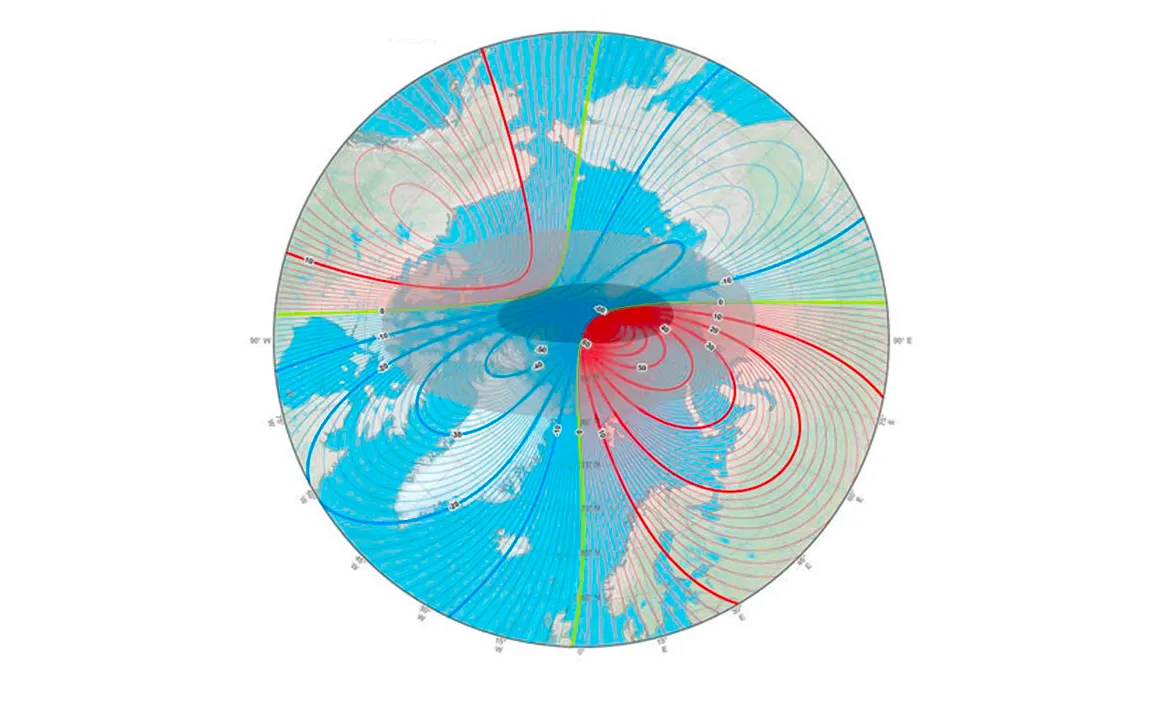For centuries, Earth’s magnetic north pole has guided explorers, navigators, and adventurers. It’s an invisible force, yet its impact has been tangible, shaping human exploration and aiding technology like compasses and GPS systems. But in recent decades, the magnetic north pole has shown unprecedented behavior, moving rapidly across the Arctic. In a significant scientific update, researchers have pinpointed its latest position and issued new guidelines to ensure navigation systems remain accurate.
The Nature of Magnetic North
Unlike the geographic North Pole, the magnetic north pole isn’t fixed. It is the point where Earth’s magnetic field, generated by the motion of molten iron in the planet’s outer core, points vertically downwards. For centuries, it moved at a relatively modest pace, but around the late 20th century, it began accelerating. Today, it is shifting at speeds of about 40 kilometers (25 miles) per year—several times faster than its historical average.
A phenomenon that has puzzled scientists prompted them to research anew why the pole is shifting so fast and where it could next, as its historic path has kept it within Canada, but now has taken it into the Arctic Ocean and closer to Siberia, bringing forth concerns about the navigational situation, climate studies, and our ability to understand Earth’s inner workings.
Why Does Magnetic North Move?
The movement of the magnetic north pole is also linked to the dynamic nature of Earth’s magnetic field. This is a field created by the geodynamo, the process occurring within the liquid outer core, as molten iron and nickel move in a cycle that creates electric currents. The resulting magnetic field shoots out into space, shielding the planet from destructive solar radiation and guiding myriad technologies.
According to scientists, the magnetic north pole’s current behavior is related to irregularities in the geodynamo. For the past decades, researchers have found two rival magnetic “blobs” of molten material beneath Canada and Siberia. The Siberian blob seems to be getting stronger, drawing the magnetic north pole toward it. This explains why it is moving eastward; however, the speed at which it moves is still under active research.
Updating the Position
The World Magnetic Model, a very important tool that civilian and military navigation systems rely upon, has recently been updated based on the pole’s location. Normally, the WMM is updated every five years. However, given the rapid change in the position of the magnetic north pole, it was up-dated before schedule in 2019 to emphasize its value. The last measured position from satellite data and ground observations puts the pole just off the northern coast of Russia.
This upgrade makes sure that the navigation system used in both a smartphone and in ships and aircrafts continues to be accurate. Though contemporary GPS technology utilizes satellites for locating, many of these systems are still using magnetic data for orientation and course correction. An inexact magnetic model would lead to inaccuracies, particularly in polar regions where navigation is already complicated due to the convergence of magnetic field lines.
Implications for Navigation and Technology
The shift in the magnetic north has many serious implications. For example, aviation and shipping, for example, need very accurate magnetic information about their destinations in order for flights and sailing not to constitute hazards. Pilots require magnetic headings as the basis to begin take-off and landing, while mariners take direction from compasses. Slightly small inaccuracies could lead to severe consequences mainly when GPS is too weak in certain remote or hidden areas.
The changes also affect smartphone navigation apps, which rely on magnetometers for providing compass readings. Without periodic updates of the WMM, these apps would mislead users, especially in areas near the poles. For example, hikers or adventurers who rely on compass-based navigation might be off track if the magnetic data is outdated.
Wider Scientific and Environmental Questions
Beyond navigation, the wandering magnetic north pole points to curiosity about Earth’s magnetic field itself. One area of interest is the possibility of a magnetic pole reversal, in which the positions of magnetic north and magnetic south are exchanged. These reversals have happened many times in Earth’s history; the most recent occurred about 780,000 years ago. While scientists say this is not going to happen soon, the current changes underline how complicated Earth’s magnetic behavior is.
Another significant area of concern is weakening Earth’s magnetic field. Data from satellites indicate that this field has been weakening gradually over the last two centuries. A weakened field might cause the planet to be exposed to significant increased levels of solar radiation, thereby sometimes rendering the power grids, communication systems, and satellites ineffective.
The changes also intersect with climate science. Though the magnetic field does not have a direct role to play in weather formation, the poles’ movement reminds one of Earth’s dynamic systems and their interconnectedness. Understanding the shifts can help scientists build more accurate models of the planet’s processes-from core dynamics to atmospheric behavior.
The Way Forward
Scientists are monitoring the magnetic north pole closely, deploying all manner of spacecraft to ground observatories. That effort will seek to refine predictions about future motions and consider further the broader ramifications of a dynamic magnetic field.
For the public, the take-home message is that everyone needs to stay updated. Navigation systems, apps, and maps must be updated so they mirror the latest magnetic data. This movement of the north magnetic pole might not be visible to naked eyes but affects its impact across technology, transportation, and science as it touches many lives that people are not aware of.
Conclusion
Earth’s magnetic north pole is more than a scientific curiosity—it’s a cornerstone of modern navigation and a window into the planet’s inner workings. Its rapid movement is a reminder of our ever-changing world and the importance of monitoring and understanding these changes. As researchers continue to unravel the mysteries of Earth’s magnetic field, updates like this one serve as both a practical guide and a call to deepen our connection with the natural forces that shape our planet.



